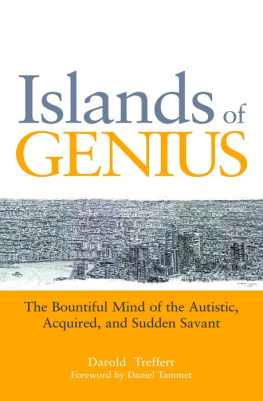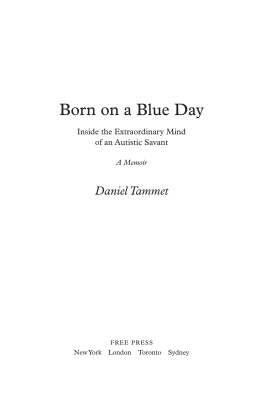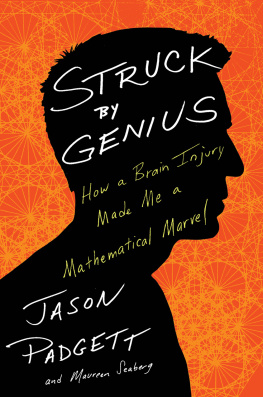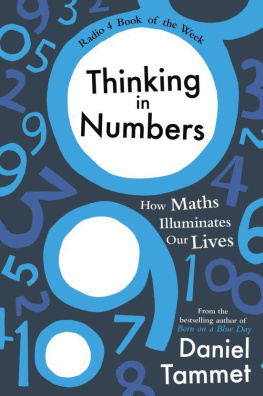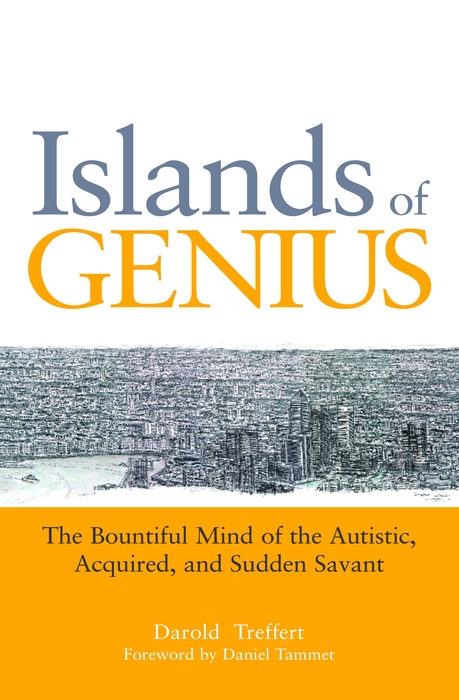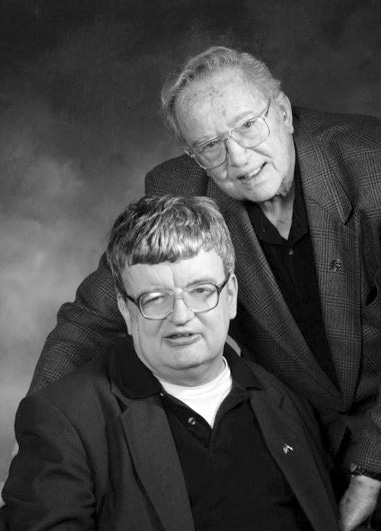Islands of Genius
The Bountiful Mind of the Autistic, Acquired, and Sudden Savant
Darold A. Treffert
Foreword by Daniel Tammet
Jessica Kingsley Publishers
London and Philadelphia
Kim and Fran Peek and Kim Peek Richard Green 2004, reproduced with permission from Salinas Valley Memorial Healthcare System, with thanks to Susan Marscellas and Janet Marcroft; Alonzo Clemons by Morey Stinson, reproduced with permission from Gifted Hands, Inc; Daniel Tammet Jerome Tabet, reproduced with permission; Stephen Wiltshire, reproduced with permission from The Stephen Wiltshire Gallery; Gregory Blackstock and The Great World Trogons (color section) reproduced with permission from the Garde Rail Gallery; Brain scan reproduced with permission from Elsevier, originally published in Lionel Feuillet, Henry Dufour and Jean Pelletier (2007) Brain of a White Collar Worker The Lancet 370, 9583, 262; Feeding Time and Bison Calf (color section) by Jeff Wells, reproduced with permission from Gifted Hands, Inc.; Megalopolis (color section) George Widener 2007, reproduced with his permission, courtesy of Henry Boxer Gallery; all other artwork and photographs have been reproduced by kind permission of the copyright holder.
First published in 2010
This edition published in 2012
by Jessica Kingsley Publishers
116 Pentonville Road
London N1 9JB, UK
and
400 Market Street, Suite 400
Philadelphia, PA 19106, USA
www.jkp.com
Copyright Darold A. Treffert 2010 and 2012
Foreword copyright Daniel Tammet 2010 and 2012
All rights reserved. No part of this publication may be reproduced in any material form (including photocopying or storing it in any medium by electronic means and whether or not transiently or incidentally to some other use of this publication) without the written permission of the copyright owner except in accordance with the provisions of the Copyright, Designs and Patents Act 1988 or under the terms of a licence issued by the Copyright Licensing Agency Ltd, Saffron House, 610 Kirby Street, London EC1N 8TS. Applications for the copyright owners written permission to reproduce any part of this publication should be addressed to the publisher.
Warning: The doing of an unauthorized act in relation to a copyright work may result in both a civil claim for damages and criminal prosecution.
Library of Congress Cataloging in Publication Data
A CIP catalog record for this book is available from the Library of Congress
British Library Cataloguing in Publication Data
A CIP catalogue record for this book is available from the British Library
ISBN 978 1 84905 873 5
eISBN 978 0 85700 318 8
Converted to eBook by EasyEPUB
Dedicated to Kim and Fran Peek, who share the same shadow, and from whom I have learned as much about matters of the heart as I have about workings of the mind
In Memoriam Kim Peek 19512009
Foreword
Savant syndrome is a rare and remarkable condition. Once sidelined by researchers, savants are now at the forefront of scientists attempts to understand the immense and fascinating complexities of the human mind.
Darold Treffert, a Wisconsin psychiatrist, writer, and lecturer, is also the worlds leading expert on savant syndrome. Over the course of five decades, he has in his many roles helped transform the publics view of differently able minds. As an advisor to the Oscar-winning movie Rainman, Dr Treffert brought global attention to the extraordinary abilities of the savant. In his writings and online presence via the Wisconsin Medical Society savant syndrome pages, he has worked tirelessly to express, explain, and clarify a phenomenon that continues to fascinate the general public and the media as much as ever before.
A savant is an individual with exceptional ability in one or more fields that co-exists with some form of disability. Many, though not all, arelike myselfon the autistic spectrum. It is this evocative mix of talent and limitation that I think so many people find particularly compelling. But proper awareness should be accorded to the human reality of both these attributes; neither the savants difficulties nor his gifts ought ever to be trivialized.
This is what, in my view, makes Dr Trefferts work unique and so important. He understands, as he argues in this book, that savants abilities go far beyond doing large sums or remembering a great deal of factual information. Savants, he acknowledges, can be highly creative. His profiles include those who have won awards for their paintings, written poetry and best-selling books, and produced whole albums of original music.
As Dr Treffert also makes clear, savants are not simply nerds, geeks, or bumbling professors. The numerous challenges they face are often significant and enduring. He is correct to highlight the hugely important role played by the savants family in their intensive ongoing care and education.
I had the pleasure of meeting Dr Treffert in person in the summer of 2004, during filming for the documentary Brainman. It was at this time, at age twenty-five, that I was first diagnosed with Asperger syndromea mild, high-functioning form of autism. It was Dr Treffert who confirmed in our interview that I was also a savant. Naturally, this meeting made a great impression on me and we have corresponded regularly ever since. When my own first book, the memoir Born On A Blue Day was published in 2006, Dr Treffert kindly agreed to write the foreword for it. His many ideas and insights proved particularly inspiring and helpful to me in the preparation and writing of my next book, Embracing the Wide Sky (2009).
As Dr Treffert mentions in his profile of me for this book, I am currently at work on my third booka novel. Many are surprised to hear this. Perhaps this is because they have never heard of an autistic person who writes literary fiction. In my memoir I describe how, as a child, I read mostly non-fictionencyclopedias and dictionaries were my favouritesrather than fiction titles. But people change, and that also includes savants. Scientists now know that the brains we are born with are not fixed at birth, as once believed, but continue to change throughout our lifetime. It is how I have learned to look people in the eye when I talk, or to understand body language, or to tell funny jokes. The savant is not, as often assumed, a prisoner of his condition.
What can savant syndrome teach normal minds? Plenty. As we read through this books many beautifully written profiles of the worlds best-known savants we discover that they have far more in common with the average person than not. Too often scientific and media discussions of the condition focus on the differences between savant and non-savant minds, to the exclusion of the many significant similarities. Savant abilities are neither the result of supercomputer-like mental processing, exhaustive rote learning, or genetic quirks. Rather they are the result of distinctly human qualities: passion, dedication, enthusiasm, love.
Few people would or should want to learn to recite Pi to 22,514 decimal places, draw landmarks in breathtaking detail, or remember the contents of 12,000 books. Everyone is different. By refusing to gawp at these feats, preferring instead to focus on the person behind them, Dr Treffert sends out the message that it is the creative, imaginative processes at the root of such abilities that matter most. Only by considering the context of savants lives can we more fully and properly understand the gifts that they possess.

